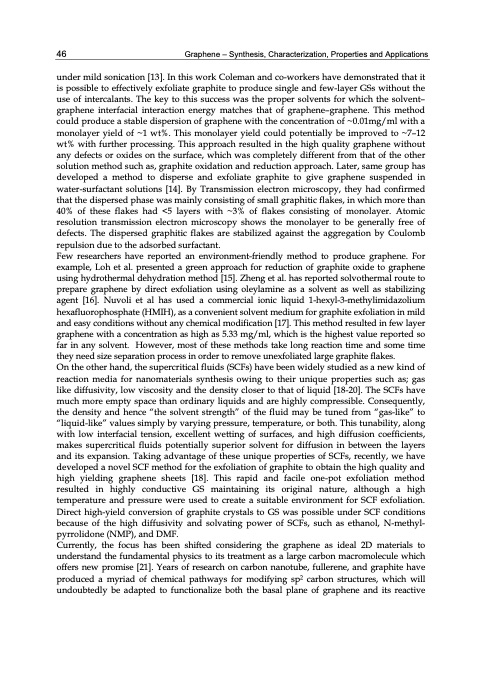
PDF Publication Title:
Text from PDF Page: 056
46 Graphene – Synthesis, Characterization, Properties and Applications under mild sonication [13]. In this work Coleman and co-workers have demonstrated that it is possible to effectively exfoliate graphite to produce single and few-layer GSs without the use of intercalants. The key to this success was the proper solvents for which the solvent– graphene interfacial interaction energy matches that of graphene–graphene. This method could produce a stable dispersion of graphene with the concentration of ~0.01mg/ml with a monolayer yield of ~1 wt%. This monolayer yield could potentially be improved to ~7–12 wt% with further processing. This approach resulted in the high quality graphene without any defects or oxides on the surface, which was completely different from that of the other solution method such as, graphite oxidation and reduction approach. Later, same group has developed a method to disperse and exfoliate graphite to give graphene suspended in water-surfactant solutions [14]. By Transmission electron microscopy, they had confirmed that the dispersed phase was mainly consisting of small graphitic flakes, in which more than 40% of these flakes had <5 layers with ~3% of flakes consisting of monolayer. Atomic resolution transmission electron microscopy shows the monolayer to be generally free of defects. The dispersed graphitic flakes are stabilized against the aggregation by Coulomb repulsion due to the adsorbed surfactant. Few researchers have reported an environment-friendly method to produce graphene. For example, Loh et al. presented a green approach for reduction of graphite oxide to graphene using hydrothermal dehydration method [15]. Zheng et al. has reported solvothermal route to prepare graphene by direct exfoliation using oleylamine as a solvent as well as stabilizing agent [16]. Nuvoli et al has used a commercial ionic liquid 1-hexyl-3-methylimidazolium hexafluorophosphate (HMIH), as a convenient solvent medium for graphite exfoliation in mild and easy conditions without any chemical modification [17]. This method resulted in few layer graphene with a concentration as high as 5.33 mg/ml, which is the highest value reported so far in any solvent. However, most of these methods take long reaction time and some time they need size separation process in order to remove unexfoliated large graphite flakes. On the other hand, the supercritical fluids (SCFs) have been widely studied as a new kind of reaction media for nanomaterials synthesis owing to their unique properties such as; gas like diffusivity, low viscosity and the density closer to that of liquid [18-20]. The SCFs have much more empty space than ordinary liquids and are highly compressible. Consequently, the density and hence “the solvent strength” of the fluid may be tuned from “gas-like” to “liquid-like” values simply by varying pressure, temperature, or both. This tunability, along with low interfacial tension, excellent wetting of surfaces, and high diffusion coefficients, makes supercritical fluids potentially superior solvent for diffusion in between the layers and its expansion. Taking advantage of these unique properties of SCFs, recently, we have developed a novel SCF method for the exfoliation of graphite to obtain the high quality and high yielding graphene sheets [18]. This rapid and facile one-pot exfoliation method resulted in highly conductive GS maintaining its original nature, although a high temperature and pressure were used to create a suitable environment for SCF exfoliation. Direct high-yield conversion of graphite crystals to GS was possible under SCF conditions because of the high diffusivity and solvating power of SCFs, such as ethanol, N-methyl- pyrrolidone (NMP), and DMF. Currently, the focus has been shifted considering the graphene as ideal 2D materials to understand the fundamental physics to its treatment as a large carbon macromolecule which offers new promise [21]. Years of research on carbon nanotube, fullerene, and graphite have produced a myriad of chemical pathways for modifying sp2 carbon structures, which will undoubtedly be adapted to functionalize both the basal plane of graphene and its reactivePDF Image | GRAPHENE SYNTHESIS CHARACTERIZATION PROPERTIES

PDF Search Title:
GRAPHENE SYNTHESIS CHARACTERIZATION PROPERTIESOriginal File Name Searched:
Graphene-Synthesis.pdfDIY PDF Search: Google It | Yahoo | Bing
Salgenx Redox Flow Battery Technology: Power up your energy storage game with Salgenx Salt Water Battery. With its advanced technology, the flow battery provides reliable, scalable, and sustainable energy storage for utility-scale projects. Upgrade to a Salgenx flow battery today and take control of your energy future.
| CONTACT TEL: 608-238-6001 Email: greg@infinityturbine.com | RSS | AMP |